Statistical highlights of 2006
January 5, 2007
A year dominated by Yousuf, Murali and Australia
Statistically, 2006 has been a gold mine in both Tests and one-day internationals. Cricinfo looks back at the highlights of an extraordinary year of cricket
Statistically, 2006 has been a gold mine in both Tests and one-day internationals. The Johannesburg chase, Mohammad Yousuf's Bradmanesque form are a couple of highlights of an eventful year. Cricinfo turns the clock back.

|
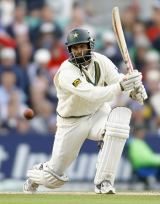
Mohammad Yousuf averaged 99.33 in 2006, and broke two of Viv Richards's 30-year old records
© Getty Images
|
|
Australia were undefeated in Tests in 2006, winning all ten of their matches. West Indies and Bangladesh are the only teams that didn't win a Test in 2006. South Africa's record may raise an eyebrow as well - seven defeats, three victories and one draw.
Topping the batting averages is - hold your breath - Jason Gillespie, thanks to a freak innings and his subsequent omission from the Australian team. He played three innings - 26, 4* and 201* - against Bangladesh in April, giving him an average of 231, outstripping Mohammad Yousuf, who takes second place. The three names that follow Yousuf explain why Australia have had an awesome run in 2006 - Ricky Ponting , Michael Hussey and Michael Clarke are numbers three, four and five.
Nine batsman scored more than 1000 Test runs in the year, the second highest in Test history after 2004, in which eleven batsmen scored 1000 plus. 2005, 2003 and 2002 had six batsmen with more than 1000 runs.
When it came to amassing runs, no one could touch Mohammad Yousuf. His total of 1788 in 19 innings broke Viv Richards's 30-year old record for most runs in a calendar year . He also scored nine hundreds and took the record for most centuries in a year from Richards, who'd scored seven in 1976. Ricky Ponting also equalled Richards's tally of seven centuries in a year in 2006.

|
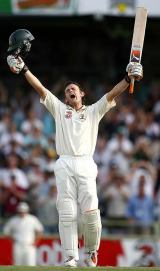
Adam Gilchrist celebrates the second fastest century against England at Perth
© Getty Images
|
|
Yousuf also scored centuries in five consecutive Tests in 2006 and is in second place with Jacques Kallis for most centuries in consecutive matches . Only Sir Don Bradman, who made hundreds in six consecutive Tests, is ahead of him - and Yousuf can break that record on the tour of South Africa.
The list of highest runscorers has one surprise among the usual suspects: Paul Collingwood, who wasn't even a regular in the Test side before 2006. However, he ground out 1121 in 14 Tests , the sixth highest in 2006, at 50.95. He was also the first England batsman to score a double century in Australia since Wally Hammond in 1936.
Another one of Richards's records nearly fell this year when Adam Gilchrist hit England all over the WACA; he took 57 balls to reach his century, one more than Richards needed to smash a hundred against England at Antigua in 1986. However, Gilchrist did reclaim his record for the fastest century by a wicketkeeper from Kamran Akmal, who scored a century off 81 balls against India at Lahore .
Sehwag's 254 off 247 balls against Pakistan at Lahore was the highest Test score made at more than a run a ball. Nathan Astle held the previous record, with his innings of 222 off 168 balls against England at Christchurch.
The Lahore Test between India and Pakistan was also the first to have two triple-century partnerships. Mohammad Yousuf and Younis Khan put on 319 while Dravid and Sehwag put on 410.

|
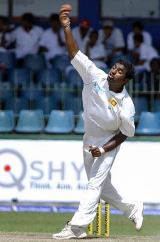
Muttiah Muralitharan took 22 wickets against South Africa and broke the record for most wickets in a two-Test series
© AFP
|
|
The 410-run partnership between Sehwag and Rahul Dravid at Lahore was the second-highest opening partnership in history, falling three runs short of the world record set by Pankaj Roy and Vinoo Mankad against New Zealand at Madras in 1955-56.
Mahela Jayawardene and Kumar Sangakkara broke the world record for the highest partnership for any wicket when they amassed 624 for the third wicket against South Africa at the SSC in Colombo. They surpassed the 576 put on by Sanath Jayasuriya and Roshan Mahanama for the second wicket against India at the Premadasa in 1997.
Younis Khan and Mohammad Yousuf broke the record for the highest partnership in a lost Test when they added 363 for the third wicket at Headingley. In December Kevin Pietersen and Paul Collingwood shared a 310-run stand at Adelaide, which is the second highest partnership in a lost match.
Shane Warne became the first player to take 700 Test wickets when he bowled Andrew Strauss during the fourth Ashes Test at Melbourne. Shaun Pollock became the first South African to take 400 Test wickets when he dismissed Rahul Dravid in the second innings at Johannesburg.
Muttiah Muralitharan had an outstanding year , taking 90 wickets in 11 Tests at 16.90 apiece. To put in perspective how phenomenal his year has been, look at the second place - Makhaya Ntini with 58 wickets in ten Tests at 21.60 each.

|
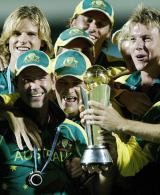
Australia ended their Champions Trophy drought in 2006
© Getty Images
|
|
Muralitharan took five ten-wicket hauls this year, breaking his own record set in 2001 when he took ten wickets in a match on four occasions.
Two newcomers have shone with the ball this year. Stuart Clark picked up 42 wickets in eight Tests at 17.76 each and also received the Man-of-the-Series award for taking 19 wickets in South Africa - his debut series. Monty Panesar was England's most successful bowler after Matthew Hoggard. He took 40 wickets in 12 Tests.
Irfan Pathan became the first bowler to take a hat-trick in the first over of a Test when he dismissed Salman Butt, Younis Khan and Mohammad Yousuf off the last three balls of the first over at Karachi.
England's under-fire wicketkeeper Geraint Jones topped the dismissals charts for 2006 with 46 catches and two stumpings in 11 Tests. He also picked up five dismissals in an innings on four occasions.

|
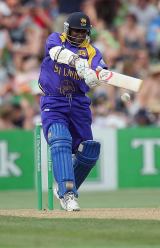
Sanath Jayasuriya treated us to his vintage 1996-97 form © Getty Images
|
|
Australia were 2006's most successful one-day team winning 20 of their 29 ODIs and losing just eight. Hidden away in those stats is their Champions Trophy victory, a feat that had eluded them on the past four occasions. Bangladesh has the second highest win-percentage of the year with 18 victories from 28 matches - most of those wins coming against Zimbabwe, Kenya and Scotland but including a memorable victory against Sri Lanka at home.
India's ODI season was in two halves; they were on fire in the first half of the year, winning 10 out of 13 ODIs against Pakistan and England. However, the tour of West Indies marked a dramatic turnaround in form - and, since that tour, India lost 12 out of 15 ODIs that have had a result. England had the worst record
among the major nations; they lost 14 of their 20 ODIs, including a 0-5 thrashing at home by Sri Lanka.
Sri Lanka's success in 2006 was largely due to the form of their top order. Kumar Sangakkara was the highest run-scorer in 2006 with 1333 runs in 33 innings at 44.43. Mahela Jayawardene, Sanath Jayasuriya and Upul Tharanga occupy third, fourth and fifth positions with over 1000 runs in the year.
Shahriar Nafees is one of six batsmen to amass over 1000 runs in 2006. He scored 1033 at 41.32, with three hundreds and four fifties, to become the first Bangladesh batsman to score 1000 runs in a calendar year.
Nathan Astle tops the batting averages of 2006 for batsmen who've played at least five matches. He's scored 586 runs in 12 matches . Michael Hussey isn't far behind, with 784 runs at 56 in 22 innings.
Jayasuriya was at his destructive best this year scoring his 1153 runs at a strike-rate of 107.45, the highest for any batsmen with over 300 runs in the year. Adam Gilchrist is a close second with a strike-rate of 103.97 for his 810 runs. Jayasuriya and his opening partner Tharanga are also 2006's highest century makers with five hundreds each.

|
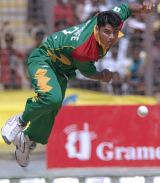
Mashrafe Mortaza surprised us all by topping the wicket tables for 2006© AFP
|
|
Guess who's taken the most ODI wickets this year? Not Murali, not Ntini, not even Pollock but Mashrafe Mortaza. He had 49 wickets at 20.46 in 2006 and also set a new Bangladesh record for best-innings figures when he took 6 for 26 against Kenya. Abdur Razzak is third with 45 wickets and at 17.95 each. Among the other bowlers only Nathan Bracken and Brett Lee have taken more than 40 wickets in 2006.
Much has been said about Shaun Pollock's drop in pace this year but there's been no let up in his relentless accuracy. His economy rate is the best among bowlers who've bowled at least 50 overs in 2006. He's conceded just 2.98 runs per over and taken 32 wickets at 17.34 apiece . Michael Yardy has also been very tight despite England's horrid ODI record. He's bowled just 36 overs this year and conceded an average of 2.94 runs per over.
Stephen Fleming begins his tenth year as captain of New Zealand in 2007; last year, he broke Arjuna Ranatunga's record (193) for most ODI caps as captain when he led New Zealand out for the 194th time during the Champions Trophy. Fleming now has 195 caps and counting at the helm.

|
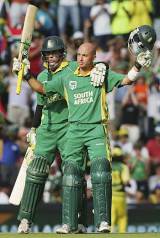
Herschelle Gibbs rewrote history hours after Australia scored 434 at the Wanderers© Getty Images
|
|
2006 will always be remembered for that match at Johannesburg when Australia smashed 434 in the first innings and surpassed Sri Lanka's 398 against Kenya in 1996 as the highest score in an ODI. Their record stood for three and a half hours as South Africa did the impossible - they finished on 438 for 9. That record stood for about four months for Sri Lanka took back their record by hammering Holland for 443 in 50 overs.
Ricky Ponting's 164 off 105 balls at the Wanderers is the highest score in a defeat in a 50-over match. Robin Smith scored 167 in a 55-over match that Australia won by six wickets. Click here for other records set in this match.
Mick Lewis got smashed for 113 off ten overs at the Wanderers, the most expensive figures in one-day cricket. He took the record of Muttiah Muralitharan, who had got hammered for 99 off his ten at Sydney in February.
South Africa and Australia smashed a total of 26 sixes and 87 fours at Johannesburg and broke the record for most fours and sixes in a match. The previous record for most sixes in a game was 21 at Christchurch in December 2005. Incidentally, India-Pakistan matches at Peshawar and Lahore this year take second and third place for most fours with 79 and 73 respectively.
Sanath Jayasuriya and Upul Tharanga broke the record for the highest opening stand in ODIs when they clobbered 286 in 31.5 overs against England at Leeds. They broke the 258 between Sachin Tendulkar and Sourav Ganguly against Kenya at Paarl in 2001.
Teams scored in excess of 300 on 24 occasions in 2006, the second highest after 2004 when 300 was exceeded 26 times.
George Binoy is editorial assistant of Cricinfo
©
ESPN Sports Media Ltd.








